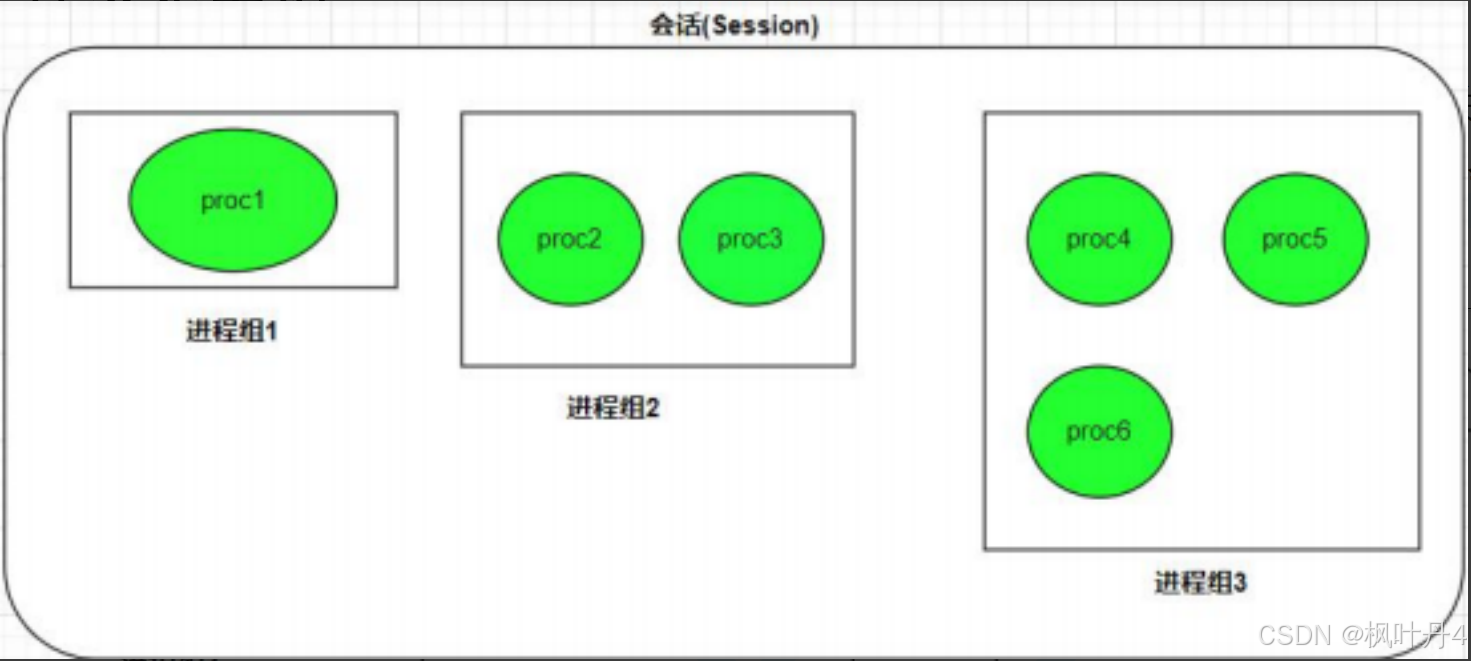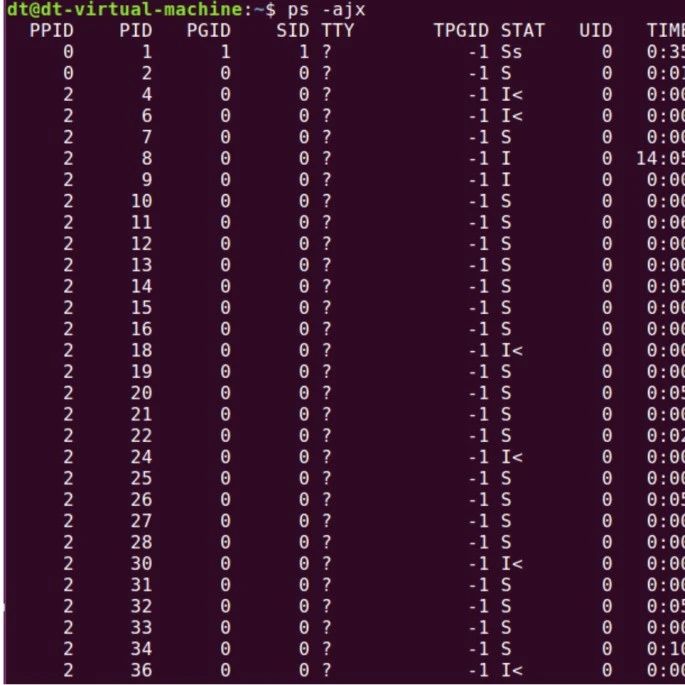从进程组、会话、终端的概念深入理解守护进程
从进程组、会话、终端的概念深入理解守护进程
写在前面
「守护进程」是 Linux 的一种长期运行的后台服务进程,也有人称它为「精灵进程」。我们常见的 httpd、named、sshd 等服务都是以守护进程 Daemon 方式运行的,通常服务名称以字母d结尾,也就是 Daemon 第一个字母。与普通进程相比它大概有如下特点:
- 无需控制终端(不需要与用户交互)
- 在后台运行
- 生命周期比较长,一般是随系统启动和关闭
守护进程必要性
为什么要设置为守护进程,普通进程不可以吗?
当我们在命令行提示符后输入类似./helloworld程序时,在程序运行时终端被占用,此时无法执行其它操作。即使使用./helloworld &方式后台运行,当连接终端的网络出现问题,那么也会导致运行程序中断。这些因素对于长期运行的服务来说很不友好,而「守护进程」可以很好的解决这个问题。
对进程组、会话、终端的理解
「守护进程」理解起来并不复杂,代码编写上有基本固定的套路。如果想要深入理解「守护进程」基本原理,那么必须要首先理解 Linux 的进程、进程组、会话、终端等概念。
1、进程
- 进程是 Linux 进行资源分配的最小单位
- 前台进程,例如这样:
$ ./hello - 后台进程,例如这样:
$ ./hello &释放对控制终端的占用
2、进程组
每个进程都会属于一个进程组,进程组中可以包含一个或多个进程。进程组中有一个进程组长,组长的进程 ID 是进程组 ID(PGID)
$ ps -o pid,pgid,ppid,comm | cat
PID PGID PPID COMMAND
10179 10179 10177 bash
10263 10263 10179 ps
10264 10263 10179 cat下边通过简单的示例来理解进程组
- bash:进程和进程组ID都是 10179,父进程其实是 sshd(10177)
- ps:进程和进程组ID都是 10263,父进程是 bash(10179),因为是在 Shell 上执行的命令
- cat:进程组 ID 与 ps 的进程组 ID 相同,父进程同样是 bash(10179)
容易理解 Bash 就是Shell进程,Shell 父进程是 sshd;ps 与 cat 通过管道符号一起运行,属于一个进程组,其父进程都是 Bash;一个进程组也被称为「作业」。
3、会话(session)
多个进程组构成一个「会话」,建立会话的进程是会话的领导进程,该进程 ID 为会话的 SID。会话中的每个进程组称为一个「作业」。会话可以有一个进程组称为会话的「前台作业」,其它进程组为「后台作业」
一个会话可以有一个控制终端,当控制终端有输入和输出时都会传递给前台进程组,比如Ctrl + Z。会话的意义在于能将多个作业通过一个终端控制,一个前台操作,其它后台运行。
4、前后台作业相关操作
让作业由进入后台运行:
$ ping localhost >/dev/null &
[1] 10269 # 终端显示
# [1]:作业ID 10269:进程组ID给后台作业发信号 SIGTERM
$ kill -SIGTERM -10269 # 发信号给进程组
$ kill -SIGTERM %1 # 发信号给作业1让后台进程切换到前台:
$ fg %1
# ping 进程重新切到前台编写守护进程
编写守护进程看似复杂,但实际上也是遵循一个特定的流程。
1、创建子进程,父进程退出
进程 fork 后,父进程退出。这么做的原因有 2 点:
- 如果守护进程是通过 Shell 启动,父进程退出,Shell 就会认为任务执行完毕,这时子进程由 init 收养
- 子进程继承父进程的进程组 ID,保证了子进程不是进程组组长,因为后边调用
setsid()要求必须不是进程组长
2、子进程创建新会话
调用setsid()创建一个新的会话,并成为新会话组长。这个步骤主要是要与继承父进程的会话、进程组、终端脱离关系。
3、禁止子进程重新打开终端
此刻子进程是会话组长,为了防止子进程重新打开终端,再次 fork 后退出父进程,也就是此子进程。这时子进程 2 不再是会话组长,无法再打开终端。其实这一步骤不是必须的,不过加上这一步骤会显得更加严谨。
4、设置当前目录为根目录
如果守护进程的当前工作目录是/usr/home目录,那么管理员在卸载/usr分区时会报错的。为了避免这个问题,可以调用chdir()函数将工作目录设置为根目录/。
5、设置文件权限掩码
文件权限掩码是指屏蔽掉文件权限中的对应位。由于使用 fork()函数新建的子进程继承了父进程的文件权限掩码,这就给该子进程使用文件带来了诸多的麻烦。因此,把文件权限掩码设置为 0,可以大大增强该守护进程的灵活性。通常使用方法是umask(0)。
6、关闭文件描述符
子进程会继承已经打开的文件,它们占用系统资源,且可能导致所在文件系统无法卸载。此时守护进程与终端脱离,常说的输入、输出、错误描述符也应该关闭。
守护进程的出错处理
由于守护进程脱离了终端,不能将错误信息输出到控制终端,即使 gdb 也无法正常调试。常用的方法是使用 syslog 服务,将错误信息输入到/var/log/messages中。
syslog 是 Linux 中的系统日志管理服务,通过守护进程 syslogd 来维护。该守护进程在启动时会读一个配置文件/etc/syslog.conf。该文件决定了不同种类的消息会发送向何处。
守护进程编码示例
pid_t pid, sid;
int i;
openlog("daemon_syslog", LOG_PID, LOG_DAEMON);
pid = fork(); // 第1步
if (pid < 0) exit(-1);
else if (pid > 0) exit(0); // 父进程第一次退出
if ((sid = setsid()) < 0) // 第2步
{
syslog(LOG_ERR, "%s\n", "setsid");
exit(-1);
}
// 第3步 第二次父进程退出
if ((pid = fork()) > 0) exit(0);
if ((sid = chdir("/")) < 0) // 第4步
{
syslog(LOG_ERR, "%s\n", "chdir");
exit(-1);
}
umask(0); // 第5步
// 第6步:关闭继承的文件描述符
for(i = 0; i < getdtablesize(); i++)
{
close(i);
}
while(1)
{
do_something();
}
closelog();
exit(0);到这里基本上把守护进程的内容全部说清楚了,内容不少,概念比较晦涩,如果希望理解的比较透彻的话,可能需要多看几遍了。
- 写在前面
- 守护进程必要性
- 对进程组、会话、终端的理解
- 1、进程
- 2、进程组
- 3、会话(session)
- 4、前后台作业相关操作
- 编写守护进程
- 1、创建子进程,父进程退出
- 2、子进程创建新会话
- 3、禁止子进程重新打开终端
- 4、设置当前目录为根目录
- 5、设置文件权限掩码
- 6、关闭文件描述符
- 守护进程的出错处理
- 守护进程编码示例

腾讯云开发者

扫码关注腾讯云开发者
领取腾讯云代金券
Copyright © 2013 - 2025 Tencent Cloud. All Rights Reserved. 腾讯云 版权所有
深圳市腾讯计算机系统有限公司 ICP备案/许可证号:粤B2-20090059 深公网安备号 44030502008569
腾讯云计算(北京)有限责任公司 京ICP证150476号 | 京ICP备11018762号 | 京公网安备号11010802020287
Copyright © 2013 - 2025 Tencent Cloud.
All Rights Reserved. 腾讯云 版权所有









